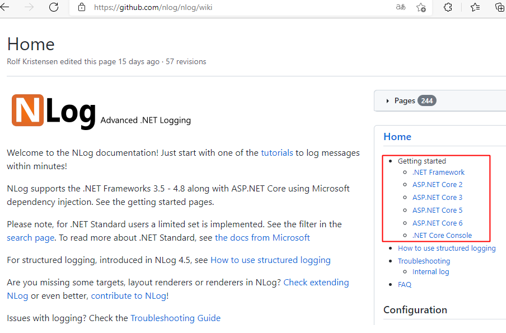NLog官方教程 https://github.com/nlog/nlog/wiki

在.NET Core集成NLog
1.通过NuGet 安装包

2.创建配置文件 nlog.config ,将文件的“复制到输出目录”属性设置为始终复制
<?xml version="1.0" encoding="utf-8" ?>
<nlog xmlns="http://www.nlog-project.org/schemas/NLog.xsd"
xmlns:xsi="http://www.w3.org/2001/XMLSchema-instance"
autoReload="true"
throwConfigExceptions="true">
<!-- enable asp.net core layout renderers -->
<extensions>
<add assembly="NLog.Web.AspNetCore"/>
</extensions>
<!-- the targets to write to -->
<targets>
<!-- File Target for all log messages with basic details -->
<target xsi:type="File" name="allfile" fileName=".\nolog\nlog-AspNetCore3-all-${shortdate}.log"
layout="${longdate}|${event-properties:item=EventId_Id:whenEmpty=0}|${uppercase:${level}}|${logger}|${message} ${exception:format=tostring}" />
</targets>
<!-- rules to map from logger name to target -->
<rules>
<!--All logs, including from Microsoft-->
<logger name="*" minlevel="Trace" writeTo="allfile" />
<!--Skip non-critical Microsoft logs and so log only own logs-->
<logger name="Microsoft.*" maxlevel="Info" final="true" />
</rules>
</nlog>
3. 在program.cs 配置使用NLog
public static IHostBuilder CreateHostBuilder(string[] args) =>
Host.CreateDefaultBuilder(args)
.ConfigureWebHostDefaults(webBuilder =>
{
webBuilder.UseStartup<Startup>();
})
.ConfigureLogging(logging => {
logging.ClearProviders();
logging.SetMinimumLevel(Microsoft.Extensions.Logging.LogLevel.Trace);
})
.UseNLog()//设置 NLog 组件 可以依赖注入
;
4.修改appsettings.json 的日记等级,如果有appsettings.Development.json文件,就同意修改。
"LogLevel": {
"Default": "Trace",
"Microsoft": "Warning",
"Microsoft.Hosting.Lifetime": "Information"
}
5.写日记,通过依赖注入获取写日记对象,然后就可以执行写入了
using Microsoft.Extensions.Logging;
public class HomeController : Controller
{
private readonly ILogger<HomeController> _logger;
public HomeController(ILogger<HomeController> logger)
{
_logger = logger;
_logger.LogDebug(1, "NLog injected into HomeController");
}
public IActionResult Index()
{
_logger.LogInformation("Hello, this is the index!");
return View();
}
6.查看生成的日记



